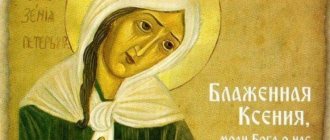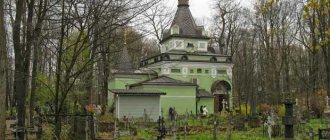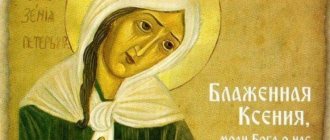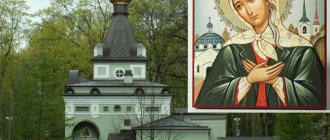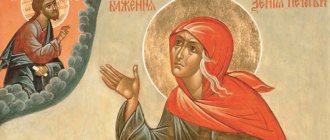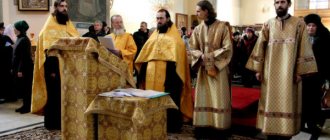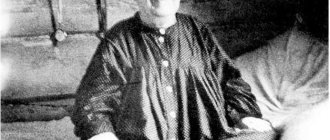Akathist to Saint Blessed Xenia of Petersburg
Saint Blessed Xenia was born between 1719 and 1731. Nothing is known about the saint’s parents, her childhood and adolescence. It is only known that the blessed woman’s father’s name was Gregory.
Upon reaching adulthood, Ksenia Grigorievna married the court singer, Colonel Andrei Feodorovich Petrov, and lived with her husband in St. Petersburg. But the Lord did not destined the young couple to walk together along the path of life for long: Andrei Feodorovich suddenly died, leaving his wife a widow in the twenty-sixth year of her life.
This tragic event changed the life of a young woman. She was deeply shocked that her husband died without proper Christian preparation and did not have time to repent. Ksenia decided that with the feat of life she would beg God for forgiveness of the sins of God's servant Andrei.
On the day of her husband’s funeral, Ksenia Grigorievna put on his clothes and told everyone who approached her with condolences that it was not Andrei Fedorovich who died, but his wife Ksenia Grigorievna. From that moment on, she truly died for the world, having taken upon herself the most difficult feat - the feat of foolishness for Christ's sake.
She immediately seemed to forget everything earthly, human, all joys and pleasures, and as a result of this she seemed to many to be crazy, having lost her mind. Even her relatives and friends began to look at her this way, and especially after Ksenia gave away all her property to the poor and gave the house to her good friend, Paraskeva Antonova. Ksenia’s relatives, who believed that the young widow had lost her mind due to the grief that had fallen on her shoulders, even submitted a petition to the authorities of the deceased Andrei Feodorovich, asking not to allow Ksenia to give away her property in madness. The superiors of the deceased Petrov summoned Ksenia to their place, but after talking with her they were completely convinced that Ksenia was completely healthy, and therefore had the right to dispose of her property as she pleased.
Freed from all earthly cares, Saint Xenia walked the difficult path of foolishness for the sake of Christ. Dressed in her husband’s suit, that is, putting on his underwear, caftan, camisole, she still assured people that Andrei Feodorovich was alive, and his wife Ksenia had died. She never responded if she was called Ksenia Grigorievna, but she always responded willingly if she was called Andrei Feodorovich.
Ksenia did not have any specific place of residence. For the most part, she spent the whole day wandering around the St. Petersburg side and mainly in the area of the parish of the Church of St. Apostle Matthias (now Bolshaya Pushkarskaya Street, building 35), where at that time poor people lived in small wooden houses. The strange costume of the poor, barely shod woman, who had no place to lay her head, her allegorical conversations, her complete meekness, and gentleness often gave evil people and especially street boys the reason and courage to mock the blessed one. The blessed one endured all these reproaches without complaint. Only once, when Ksenia had already begun to be revered as a saint of God, did the residents of the St. Petersburg side see her in great anger. The boys’ bullying that time exceeded all human patience; they swore and threw stones and dirt at her. Since then, local residents have put a stop to her street harassment.
Little by little they became accustomed to the blessed one’s oddities. When Andrei Fedorovich's costume decayed and fell apart, the saint dressed herself in rags. They began to offer her warm clothes and money, but Ksenia would never agree to exchange her rags and spent her entire life in a red blouse and a green skirt, or vice versa - a green blouse and a red skirt. Probably in memory of the colors of my husband's uniform. She also did not accept alms, but only took from good people the “king on a horse” (kopecks with the image of a horseman[1]) and immediately gave this “king on a horse” to the same poor people as she herself.
Wandering the streets of St. Petersburg all day, Ksenia occasionally visited her friends, dined with them, talked, and then set off to wander again. Where she spent her nights remained unknown for a long time. Not only residents of the St. Petersburg side became interested in this, but also the local police, for whom the location of the blessed one at night even seemed suspicious. It was decided to find out where this strange woman spends her nights and what she does. It turned out that Ksenia, no matter what time of year or weather, went to the field for the night and stood there in kneeling prayer until dawn, alternately bowing to the ground on all four sides.
In 1786-1790, under the leadership of priest Georgy Petrov and according to the design of architect Alexei Ivanov, the stone Smolensk Church was built at the Smolensk cemetery in St. Petersburg. The workers working on the construction of the temple noticed strange things. During their absence, at night, someone carried bricks to the scaffolding of the church under construction. Finally, they decided to find out who this free, tireless worker could be, carrying bricks for them every night. It turned out that it was the servant of God, blessed Ksenia.
For her great deeds and patience, the Lord glorified his chosen one during her lifetime. The servant of God Ksenia was awarded the gift of insight into hearts and the future. She predicted the death of Empress Elizabeth Petrovna (1762) and the young Emperor Ivan Antonovich (1764), and helped one girl avoid marriage with an escaped convict posing as the colonel he had killed.
Teaching people truthfulness, Blessed Xenia often revealed the secrets of those people whom she visited. She secretly predicted the death of the merchant Krapivnina, saying: “The nettle is green, but it will soon fade,” and she predicted marriage for one poor girl.
One day she told her old friend Paraskeva Antonova, the same one to whom she gave the house, to immediately go to the Smolensk cemetery: “You’re sitting here darning your stockings, but you don’t know that God sent you a son!” Paraskeva walked towards the cemetery in bewilderment and suddenly saw a crowd of people. It turned out that the crew had crushed to death a pregnant woman who had given birth to a boy before her death. Paraskeva took him for herself, and since she could not find the baby’s father anywhere, she adopted him. The adopted son raised by her revered her as a mother and in her old age protected the peace of Paraskeva, who thanked the blessed one for her great joy.
Residents of the St. Petersburg side noticed that if the blessed one took a sick child in her arms or blessed him, he would certainly recover. If he takes some small change from a merchant’s shop, the trade will be successful. If she enters the house, then peace and harmony will reign in the house.
Blessed Xenia carried out the feat of voluntary madness for 45 years and died around 1803. Her body was buried in the Smolensk cemetery. And many signs of God’s mercy began to take place at her tomb. After a memorial service was performed over her grave, the sufferers received healing, broken peace was restored in families, and the needy received what they needed.
People who revered Blessed Xenia removed the earth from her burial mound, so that the mound was filled several times. Later, a stone slab was laid on the site of the hill, which was also dismantled stone by stone. In the third quarter of the 19th century, a small chapel was built on this site, and in 1902, according to the design of the architect Alexander Vseslavin, a large stone chapel was erected. During the Soviet years, the chapel was closed, but no amount of effort by atheists could suppress among the people the memory of the blessed one and the faith in her prayerful intercession before the throne of God.
Another memorable place associated with Saint Xenia is located on the Petrograd side - this is Lakhtinskaya Street, where Ksenia lived with her husband. Their house was either at the beginning of the street, later named after her husband - “Andrei Petrov” (from 1877 - Lakhtinskaya), that is, near Bolshoy Prospekt, or between houses 15 and 19 on Lakhtinskaya Street (in 2022 a temple was erected here Saint Xenia of Petersburg).
After many years of popular veneration, Blessed Xenia of St. Petersburg, the Fool for Christ's sake, was canonized on June 6, 1988 at the Local Council of the Russian Orthodox Church. And even earlier - on September 24, 1978 - Xenia of Petersburg was canonized by the Russian Orthodox Church Outside of Russia. Temples in the name of Saint Xenia are located in many countries around the world, and her image can even be seen on New Zealand coins.
Note
[1] Many people think that the horseman with a spear depicted on the obverse of ancient Russian coins is St. George the Victorious slaying the serpent. But that's not true. The tradition of minting an armed horseman strengthened in Rus' during the reign of Ivan III, who is known for being able to unite the scattered Russian principalities into a single state. During this period, the silver coin became all-Russian and acquired the legend “Sovereign of All Rus',” indicating the dominion of the Moscow prince over the rest. It is the image of the prince that the warrior-ruler from the coin embodies. Thanks to the spear in the warrior’s hand, the word “kopek” appeared in the Russian language.
See also:
- Holy Blessed Xenia of Petersburg V.N. Lyalin
- Blessed Xenia of Petersburg, Holy Fool for Christ's Sake. Taisiya (Kartsova)
- Blessed Xenia of Petersburg
Popular veneration
The blessed one often visited the Smolensk cemetery on Vasilievsky Island, where her dear husband found his final refuge. Perhaps with her feat she wanted to beg for eternal salvation for him. Today it is impossible to establish the burial place of Major Petrov. Ksenia herself rested here, but many people visited her grave. They took the earth with them, giving it some healing properties.
- In 1830, a chapel was built over the saint’s grave.
- In 1902 she was consecrated. The tomb was made of marble, and an iconostasis was erected.
- Even representatives of the Soviet government did not risk destroying the holy place, such was the great public veneration. An agreement was signed between the clergy and the Council of Deputies, according to which the chapel was leased from the church.
- 1940 _ — the chapel was closed, but people continued to come to the saint’s grave. During the war, the building was turned into a warehouse, the icons were destroyed, and the tombstone was dismantled.
- 1946 _ - the chapel began to work again, at the same time the revival of the Trinity-Sergius Lavra began. The building was in terrible condition, the believers made repairs, and funeral services began. The stream of people was endless.
- 1960 - during the period of regular persecution of the Church, the holy place was closed again. Today it is open to everyone, services are held.
Various people come to the chapel, the ministers witness how they leave gifts at the icon in gratitude. This is a pious Christian tradition. In many churches there are images on which hang chains, earrings, rings, and other precious jewelry.
There is another custom in Orthodoxy - if a person personally cannot come to the chapel to Saint Xenia, he passes through his friends a note in which he states his request. Previously, all the cracks in the building were filled with letters for the heavenly intercessor. Today they are put into a special box. If you have no one to send the message to, you can use regular mail.
- Letters and donations should be sent to the address of the Church of the Smolensk Icon of the Mother of God: 199048, St. Petersburg, Vasilyevsky Island, st. Kamskaya, house 24, to the rector. In the text, write a request to serve a prayer service or memorial service “at Ksenyushka’s.”
Many receive in return flower petals, which the ministers smear in blessed oil. They take it from the lamp, which is constantly burning at the grave. Believers also write in their letters about how the saint helped them with their problems. Gratitude is published in a newspaper called “Smolensk Temple”.
Those believers who can personally come to St. Petersburg attend divine services on Vasilievsky Island; they are held every morning at 10 a.m. On weekends, the Divine Liturgy is served twice (at 7.00 and 10.00). Evening service in summer begins at 18.00, in winter at 17.00. You can begin both confession and communion.
About the author About the book
How does the saint help?
They turn to the Blessed One in various life situations.
There are numerous cases where, through prayers to Xenia of St. Petersburg, help in love and a happy marriage were granted. Healing was sent to the terminally ill. Material problems went away, important issues were resolved, success in business appeared, conflicts between relatives stopped, and family relationships strengthened.
In addition, the Righteous One is considered the patroness of women. Each sufferer receives a response to her appeal, be it:
- a mother bringing prayers to Ksenia of Petersburg for the successful marriage of her grown-up daughter,
- a woman who dreams of becoming pregnant and giving birth to a healthy child,
- a young girl offering a prayer to Xenia of St. Petersburg with a request for the granting of love and happiness in marriage.
The holy helper is always nearby and immediately responds to a prayer call with help.
Read the prayers meaningfully, slowly, so that you feel every word spoken with your mind and heart. For greater concentration, pray in front of the icon of St. Xenia of St. Petersburg. A lit candle will help you better concentrate on prayer.
